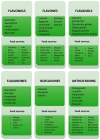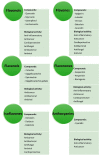Plant Flavonoids: Chemical Characteristics and Biological Activity
- PMID: 34500810
- PMCID: PMC8434187
- DOI: 10.3390/molecules26175377
Plant Flavonoids: Chemical Characteristics and Biological Activity
Abstract
In recent years, more attention has been paid to natural sources of antioxidants. Flavonoids are natural substances synthesized in several parts of plants that exhibit a high antioxidant capacity. They are a large family, presenting several classes based on their basic structure. Flavonoids have the ability to control the accumulation of reactive oxygen species (ROS) via scavenger ROS when they are formed. Therefore, these antioxidant compounds have an important role in plant stress tolerance and a high relevance in human health, mainly due to their anti-inflammatory and antimicrobial properties. In addition, flavonoids have several applications in the food industry as preservatives, pigments, and antioxidants, as well as in other industries such as cosmetics and pharmaceuticals. However, flavonoids application for industrial purposes implies extraction processes with high purity and quality. Several methodologies have been developed aimed at increasing flavonoid extraction yield and being environmentally friendly. This review presents the most abundant natural flavonoids, their structure and chemical characteristics, extraction methods, and biological activity.
Keywords: antioxidants; bioactive compounds; extraction methods; natural sources; structure.
Conflict of interest statement
The authors declare no conflict of interest.
Figures








References
-
- Ferdinando M.D., Brunetti C., Fini A., Tattini M. Flavonoids as antioxidants in plants under abiotic stresses. In: Ahmad P., Prasad M.N.V., editors. Abiotic Stress Responses in Plants: Metabolism, Productivity and Sustainability. Springer; Berlin/Heidelberg, Germany: 2012. - DOI
-
- Saini N., Gahlawat S.K., Lather V. Flavonoids: A nutraceutical and its role as anti-inflammatory and anticancer agent. In: Gahlawat S., Salar R., Siwach P., Duhan J., Kumar S., Kaur P., editors. Plant Biotechnology: Recent Advancements and Developments. Springer; Singapore: 2017. - DOI
Publication types
MeSH terms
Substances
Grants and funding
LinkOut - more resources
Full Text Sources

